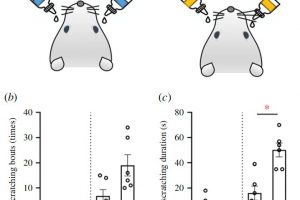Investigating the neural mechanisms behind itchy eyes in rodents


Anyone suffering dry skin, eczema, or insect bites will know the unpleasant effects of itchy skin. While the physiological mechanisms behind itching sensations on the skin are well understood, corresponding signals for the eyes are obscure.
A research group led by Associate Professor Sakamoto Hirotaka from Okayama University (Ushimado Marine Institute; UMI) and Associate Professor Takanami Keiko from Nara Women’s University has now investigated the neural mechanisms behind itchy eyes in rodents. What’s more, the group also provides insights on the limb tactics rodents adopt to mitigate this eye trouble.
Their study is published in the journal Proceedings of the Royal Society B: Biological Sciences.
Histamine, a chemical released under allergic and inflammatory conditions, is the trigger that sets into motion itching sensations. Skin-related itch signals are transmitted in neurons via a biochemical pathway known as the spinal Gastrin-releasing Peptide–Gastrin-releasing Peptide receptor (GRP-GRPR) pathway. The research team had previously revealed the presence of the GRP-GRPR pathway in nerves transmitting signals from the eyes to the brain, known as trigeminal ganglion (TG) nerves. Thus, this system was the main target of their study.
The researchers first studied scratching behavior in rats when their eyes were provoked with histamine drops. They found that when histamine was instilled in either the left or the right eye, the rats used the same-sided (as the troubled eye) hindfoot for scratching and soothing that eye. However, when histamine was used to trigger itchiness in both eyes together, the rats relied primarily on the right hindfoot for rubbing. The rats seemed to show a right-sided preference when it came to eye scratching.
Next, the focus moved on to biochemical pathways and the GRP-GRPR system. It was found that histamine intervention in either eye resulted in an increase in activity of GRPR-containing neurons in that side of the brainstem. It seemed likely, then, that the GRPR-containing neurons played a role in relaying itch signals from the eyes. To confirm this further, the team used a toxin to lesion these GRPR-containing neurons in the right side of the brainstems of rats. When these rats were then given histamine drops in the eyes, the incidence and duration of scratching was indeed less. A lack of active GRPR neurons resulted in diminished itch signals from their eyes.
“These findings could open up a new field of research on the mechanisms of the laterality in vertebrates and also offer new potential therapeutic approaches,” suggest the researchers. Besides revealing the right-sided preference animals have when using their hindlimbs, the eye scratching test used here could also be used for determining the footedness of individual rodents in future experiments. In addition, the role of the GRP-GRPR system in TG nerves revealed could be the basis for treating eye conditions that cause itchiness.

About the gastrin-releasing peptide–gastrin-releasing peptide receptor (GRP-GRPR) pathway
GRP is a neural chemical that plays a role in transmitting signals across the nervous system. Based on the location of the nerves carrying GRP, the signals vary. Nerves carrying GRP are connected to another set of nerves which contain GRPR—a partner for the GRP molecules being transmitted. When the two connect, biochemical signals are triggered in the brain.
Trigeminal ganglion (TG) neurons from the eyes carry GRP molecules into the bottom part of the brain. A region known as the spinal trigeminal nucleus caudalis (Sp5C) in this part of the brain is found to be rich in incoming GRP-containing nerve endings. Moreover, the Sp5C is abundant in GRPR. Thus, in this study the researchers targeted GRPR neurons in the Sp5C using a toxin to observe the role of this pathway in eye itchiness.
More information:
Yukitoshi Katayama et al, Footedness for scratching itchy eyes in rodents, Proceedings of the Royal Society B: Biological Sciences (2022). DOI: 10.1098/rspb.2022.1126
Journal information:
Proceedings of the Royal Society B
Source: Read Full Article